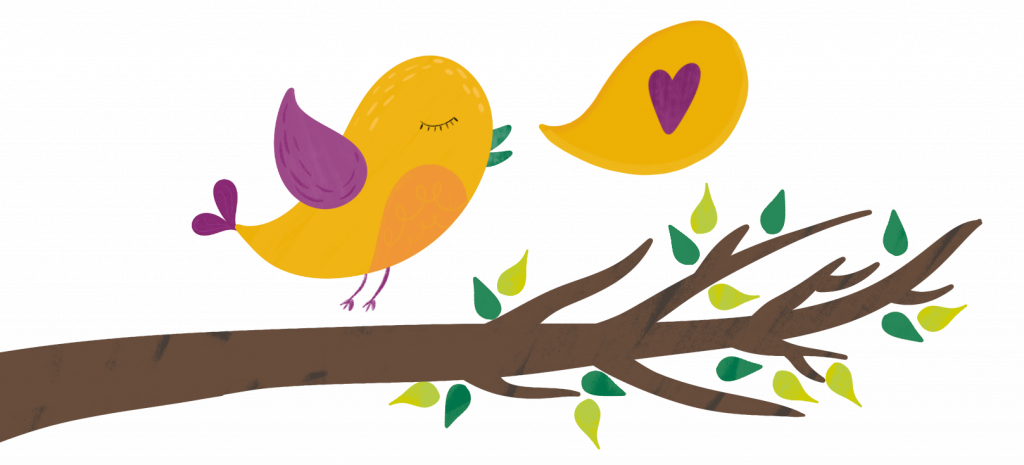Are you searching an effective way to introduce the letter q sound?
Are you wondering if the program you’re using to teach letter sounds could be more engaging for your preschool or kindergarten students?
There are different sequences for letter-sound introduction (some prefer a-to-z order while others like to start with the most common letters first), and different ideas for the best way to introduce them. I don’t have strong feelings about the particular order in which letters and sounds are introduced, but I do have an enthusiastic preference for HOW to introduce each sound and its related letter.
I used to follow a routine that went something like this:
“Let’s meet the letter q (holding up the printed letter on a card). Q says /kw/, as in queen (showing a picture of a queen on the bottom of that same card). Repeat after me, Q, queen, /kw/”.
I did this for about a decade and most of my students eventually learned to read just fine. But it seemed like it took way too long for some kids to acquire or retain the letter sounds I taught. This was especially the case when I transitioned from general education to special education and then intervention.
So after years of training in structured literacy and trying different approaches with my high-needs students, I now have a strong preference for the routine I’ll share below.
Routine for Introducing the Letter Q and Its Sound
You can watch this video in advance to get an idea of the entire routine. Or just hit play and let us introduce the letter sound q to your students right away!
Start with speech.
Why?
Our brains are wired for speaking, not reading. Talking comes naturally; reading does not. I made the switch to start with speech, as opposed to print, for that reason. I’ve also noticed increased engagement this way. Starting my lesson by asking my students to repeat words orally, and showing photographs to reinforce the meaning of each word (especially helpful for English-language learners), is not only less intimidating to young children who have no idea how to read at this point, but it’s also more fun.
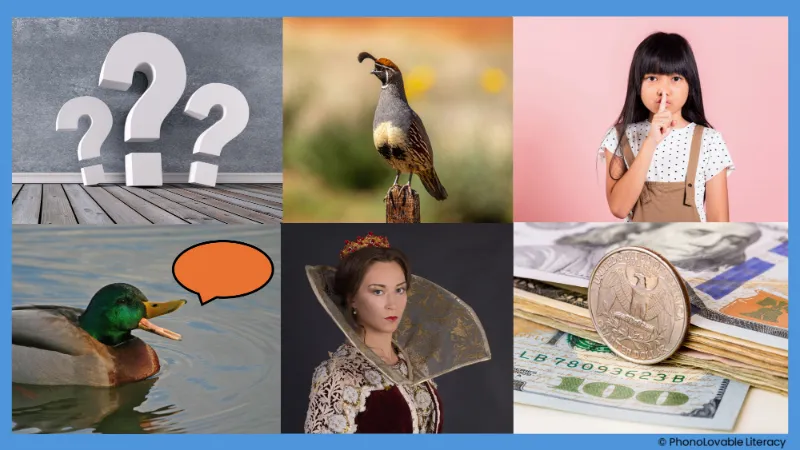

How?
Say 3-6 words that begin with the letter q, such as quail, quack, queen, and quarter. Ask children to repeat each word after you say it. If you have images, show them. If not, ask students to listen carefully and look closely at your mouth as you say each word. Tell students that all of these words begin with the sound /kw/. Try not to say /kwuh/, if possible.
Draw attention to what your mouth does when you make the /kw/ sound.
Why?
Why is the /kw/ sound represented by the letter q? There is no inherent connection. We have to explicitly draw the connection between the phoneme and the grapheme. Paying attention to what our mouths do while forming the sound helps to make this connection a little more concrete. Plus, it’s interesting for kids to discover.
How?
Ask students to observe what their mouth is doing to make the sound /kw/. If you are in small group, hold up a mirror to let students look at their own mouths. If you have a larger group, simply model with your own mouth and/or show a sound articulation card (mouth pic of a student making the sound).
Have students pay attention to the fact that the sound for the letter q is actually 2 sounds blended quickly together. You need to raise your tongue up in the back for the /k/ and round your lips tight for the /w/. The mouth pic illustrates the last part of the /kw/ sound.
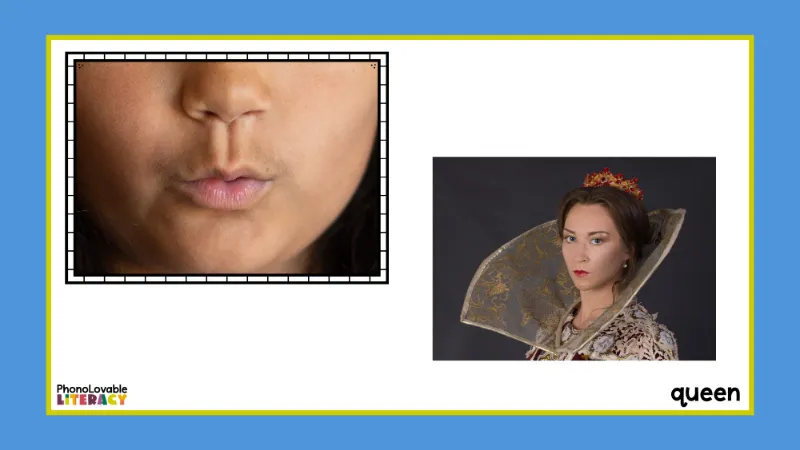

Introduce the printed letter with an EMBEDDED mnemonic.
Why?
The research on this is clear. Studies going back decades found that using embedded keyword images to teach phoneme-grapheme relationships was more effective for student acquisition AND retention of taught letter sounds than other methods. The other methods include what you’ll find in many phonics programs today – a keyword pictured above, below, or beside the printed letter. One study even found that using no picture (just a keyword) was more effective than having a picture next to (not embedded within) the letter! Having an embedded picture in the letter was the most effective method.
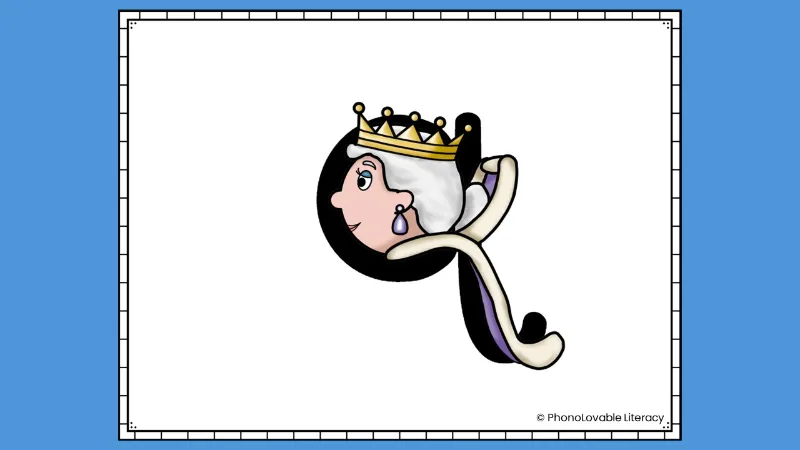

How?
Now it’s time to introduce the printed letter. But not just a plain letter, an embedded letter. The image of a keyword such as a queen in the letter q helps solidify the connection between the letter and the sound.
Model and practice how to write the letter.
Why?
Reading and writing go hand-in-hand to build a strong foundation of literacy. They are the building blocks of knowledge and expression. We teach letter sounds so that students may not only decode new words but learn to encode them as well. As an interventionist who works with students from kindergarten to 4th grade, I’ve seen how hard it is to undo incorrect letter formation once it’s become a habit. I try to prioritize letter formation as early as possible.
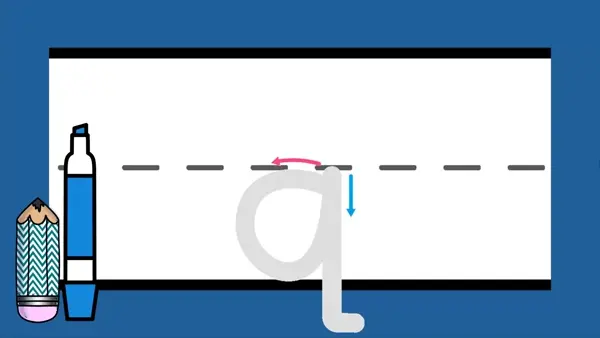

How?
I find most letter formation scrips in teacher’s guides to be complicated and formal. I try to make my language sound simple and kid-friendly so students are more likely to internalize it.
Since you’ve likely already taught students how to write the letters c and a, you could say something like this as you model how to write the lowercase letter q:
“Make a c. Push up to the middle line. Trace back down to curve a tail around (below the bottom line and up towards the right).” I remind them that we never have to pick up our pencil. Once they understand these motions, I usually simplify my directions even more and say, “Start like a c. Turn it into a q.” Or with my silly kinders, we sometimes joke “I’m making an a. Just kidding, it’s a q!”
The lowercase q is a tricky one for many children to write at first. I like to have my kids practice in a bead tray several times (sometimes guiding their hand or asking them to follow me with their finger) before they practice with a pencil or dry-erase marker.
Research-Aligned Alphabet Resources
Need easy-to-use resources to implement the steps above?
Feel free to preview our “everything bundle” of embedded letter resources, including digital slides, letter cards, worksheets, games, and more? Get your students quickly and effectively mastering letter sounds so they can begin the even more exciting discovery of how to read and write words! Current savings are at nearly 50% off for all 12 resources!
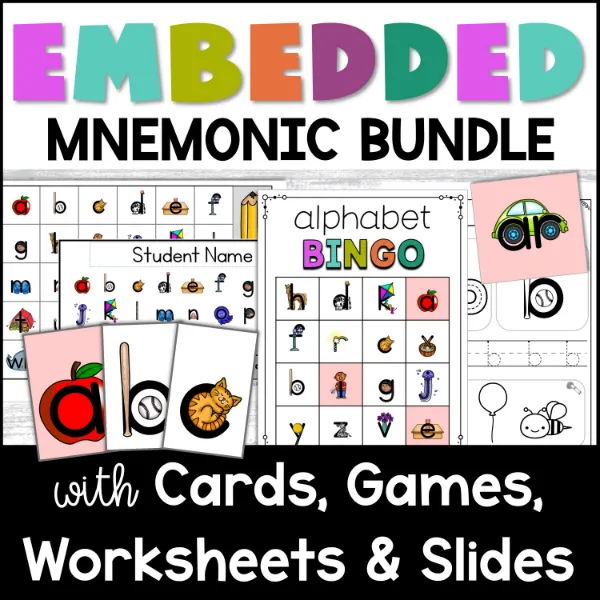

Want a free set of small embedded letter cards? When you join us in our newsletter community, we’ll send you a complementary set as a thankyou gift!
Sources:
Ehri, L. C., Deffner, N. D., & Wilce, L. S. (1984). Pictorial mnemonics for phonics. Journal of Educational Psychology, 76(5), 880–893. https://doi.org/10.1037/0022-0663.76.5.880
Ehri, L. C. (2013). Orthographic Mapping in the Acquisition of Sight Word Reading, Spelling Memory, and Vocabulary Learning. Scientific Studies of Reading, 18(1), 5–21. https://doi.org/10.1080/10888438.2013.819356
Ehri, L.C. (2022). What Teachers Need to Know and Do to Teach Letter–Sounds, Phonemic Awareness, Word Reading, and Phonics. The Reading Teacher, 76(1), 53-61. https://doi.org/10.1002/trtr.2095
McNamara, G. (2012). The effectiveness of embedded picture mnemonic alphabet cards on letter recognition and letter sound knowledge. Theses and Dissertations. 302. https://rdw.rowan.edu/etd/302
Shmidman, A., & Ehri, L. (2010). Embedded Picture Mnemonics to Learn Letters. Scientific Studies of Reading, 14(2), 159–182. https://doi.org/10.1080/10888430903117492
